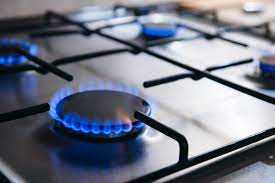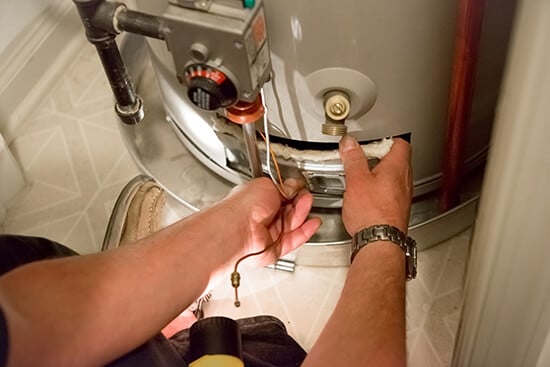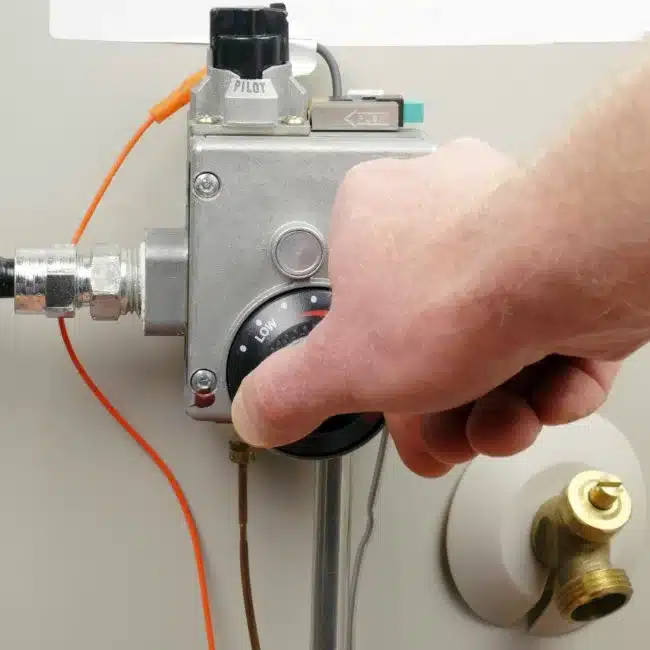The pilot light can be related to that tiny blue flame from gas furnace or water heater. A pilot light operates on a straightforward principle.
Its function is to supply the flame required to ignite the gas emitted by the main burner. A valve opens and gas is released into the burner, where it is ignited by the pilot light when the furnace “turns on”.
Let’s examine the operation of the pilot light in this article.
Table of Contents
About The Pilot Light?
A pilot light is a tiny gas flame that is used to ignite a larger gas burner. The fuel used for the pilot light is often natural gas or liquefied petroleum gas. At first, a pilot light was left burning all the time, but this wastes gas.
Gas pilot lights are still utilized when a high energy ignition source is required, such as when lighting a large burner, even though electrical burner lighting is now more frequent.
Conrad Shuck, Jr. and George Layer, two workers of the Public Service Gas Company in Newark, New Jersey, filed a US patent application on May 13, 1922, for a “safety gas-control system”.
It is also kown as an electrical indicator light that shines to indicate the presence of electrical power or the operation of an electrical device. Originally made of neon or incandescent lights, these indicators are typically LEDs now days.
A pilot light is also made in a straightforward manner. It is created by passing a tiny tube through which a tiny quantity of gas from the gas pipe is allowed to escape. When you ignite the gas that is leaking out of the tube, it continuously burns.
But as you can see, there could be a safety issue with the pilot light. The gas would continue to exit the pilot light tube in the event that the flame ever went out. An explosion would result if this gas were to gather inside your home and then catch fire.
In order to address this issue, the pilot light tube incorporates a valve that, in the unlikely event that it blows out, shuts the gas supply to the pilot light.
READ MORE: 50 Short Inspirational Memes That Put a Smile on Your Face
Pilot Light
A tiny quantity of gas that is emitted from the gas pipe powers the pilot light. A valve releases more gas when the appliance is turned on, and the pilot light ignites this gas. Occasionally, the light may need to be relit after being accidentally or purposely extinguished.
A high-voltage electric arc formed between two electrodes next to the gas flow and a red-hot surface composed of silicon carbide, silicon nitride, or any other material resistant to extended heat exposure are contemporary substitutes for the pilot light.
Residential kitchens usually employ electrical ignitions, while most commercial kitchens still use pilot lights for their ovens and grills.
A few things should be taken into account when it comes to the light:
#1. Security
There is a chance that the gas used to maintain the flame will continue to vent if a pilot light is inadvertently extinguished, potentially into the living area.
If this leak persists, its concentration might get high enough for a spark to ignite a fire or even explode, that spark could come from a cigarette lighter, static electricity, or even the light itself when it is relit.
Electrical circuitry that depends on a sensor to detect flames is used to maintain the gas flow to the pilot light as a safety measure.
Any contemporary appliance using pilot lights ought to have one or more of the following kinds of sensors installed:
- A photo-resistor that picks up the light that the pilot light emits
- A thermometer that measures the heat produced by the light.
- A voltmeter is a device that measures the electrical current generated when the flame heats a thermocouple.
- An apparatus that generates a voltage in response to temperature variation at the intersection of two distinct metals is called a thermocouple.
Building occupants are typically able to identify natural gas and propane by their odor, which is added to these inherently odorless fuels in order to warn people of potential risk.
However, when householders attempt to relight a light after the appliance’s faulty sensor fails to stop the flow of gas into the room, numerous injuries have been reported.
Continued exposure to the flame of the pilot light deteriorates thermocouples, increasing their electrical resistance and decreasing their usefulness as flame sensors. The safety risks presented by appliances with pilot lights will be reduced by routine testing and replacement of these components.
RELATED: How Does Urban Landscape Design Work?
#2. Energy Wastage
They waste a lot of fuel because pilot lights are not needed for the bulk of the time they are lighted. The precise amount of energy lost varies depending on the device, but according to several studies, a light uses between $7.50 and $18 in natural gas every month, and much more for appliances that run on propane.
Based per Cornell Environmental Health and Safety, they waste almost 20 percent of the gas utilized in the US. In addition to adding heat to the house, a light that burns continuously increases the heat load in the summer and puts undue strain on the air conditioning system. This feature may be helpful in the winter.
It’s possible that the appliance is kept in a utility room or another non-heated space even during the winter. Additionally, throughout a six-month period, a standard light can produce 450 pounds of carbon dioxide, a greenhouse gas.
To save energy, cut greenhouse gas emissions, and lower the risk of fire or explosion, an appliance’s pilot light may be extinguished if it won’t be used for an extended amount of time. Fearful homeowners can also buy appliances that include the previously suggested substitutes for the light.
They should speak with an InterNACHI inspector during their next scheduled inspection if they have any more questions or concerns about fuel-burning appliances or lights.
How Pilot Lights Work?
The primary aim of the light has always been to ensure the safe operation of gas appliances, even though its precise mechanism has evolved over time. All gas appliances, such as fireplaces, water heaters, and stoves, have lights.
See also: How to Resurface a Bathtub | Full Guide
How does it work? Below is the different steps how lights work:
#1. Standing Pilot Light
There is always a standing pilot light on. The appliance remains inoperable until the problem is fixed, as the flame only goes out when something goes wrong. To generate a little flame, a tiny amount of gas is continuously delivered via a tube.
Upon turning on the device, this flame grows larger, heating the safety valve’s bulb, which opens to let more gas into the appliance while it’s in use.
If the gas fueling a standing light went out and the pressure inside the appliance built up, it formerly had the potential to become dangerous. These days, thermocouples are installed in appliances to cut off the gas supply.
#2. Pilot Operation of Electric Ignition
When an appliance is turned on using a switch or thermostat in an electric ignition system, an electrical circuit is completed. An electric heating element is turned on when the circuit is complete. Checkout this content on: How to Repair a Garage Door: A Comprehensive Guide
Gas enters the system and is ignited by the hot element when the element reaches a particular temperature. When the appliance is turned off, the electrical circuit is disrupted and the gas stops flowing.
Because it only needs gas to run through when it’s working, this system is more efficient.
What is a Pilot Light on a Gas Stove?

A little flame known as a pilot light is maintained in several gas-fired equipment, such as your gas fireplace, water heater, and furnace.
Your appliance releases gas into the main burner when it is turned on, and the light ignites this gas to start the appliance and generate heat.
READ: 10 Reasons Why Your Air Conditioner Stopped Working & Solution
Pilot Light Water Heater

Most water heaters have a pilot light located at the bottom of the device, directly beneath the gas control valve. Examine the burner chamber by opening the access door or panel. The light tube need to be visible. Your pilot light is working if there is a continuous blue flame.
Where is The Pilot Light?

Usually found close to the front, toward the bottom of the furnace, is the light. It might be concealed by a little access panel. Certain furnaces have a small window on the front where the light is visible. Check your owner’s manual if you can’t find the pilot light on your furnace.
ALSO: How Does Dryer Vent Cleaning Work
What is a Pilot Light on a Furnace?
The tiny blue flame in your furnace that ignites the burner is called a light. Pilot lights are typical in older systems, although the majority of modern furnaces employ electric starters instead.
Frequently Asked Question
For the light to remain lit, a steady supply of gas or propane is required. The flame may extinguish for any reason related to problems with the gas valve that supplies the flame with gas, including dirt or malfunctions.
Electrical circuitry linked to the photoresistor turns off the gas valve when it goes out. Heating appliance safety is ensured by using a thermocouple or pilot generator in the flame, which produces enough electric current from the burning flame to keep the gas valve open.
Go to the “pilot” position on the valve. To reset, press and hold the button. Light the lighter if the reset button doesn’t work. When the light valve ignites, hold down the reset button and touch it with a long match or grill lighter.
The flame will go out if the pilot orifice, or opening, is clogged with soot, dust, dirt, or other debris because insufficient gas will be able to reach it. The flame color should be blue-green, as you can see. On the other hand, yellow or orange typically indicate that the entrance is unclean.





